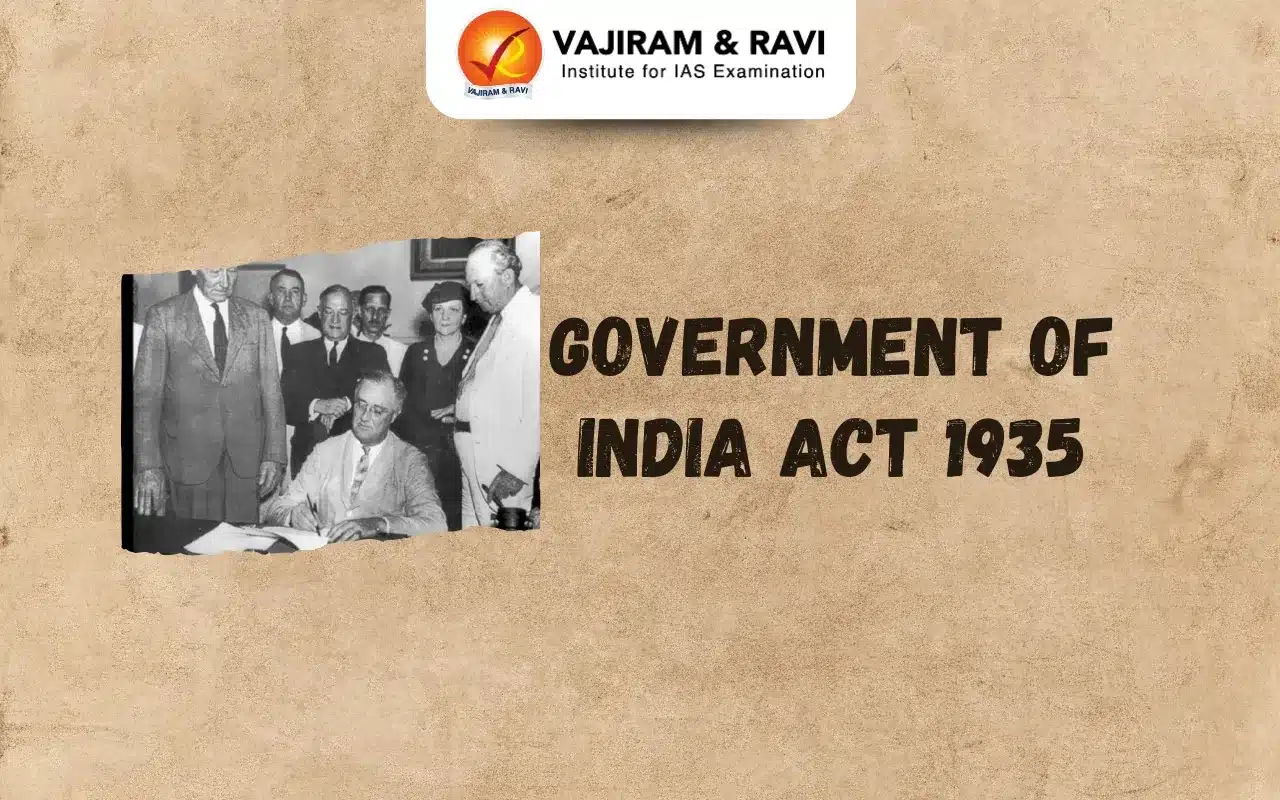The Government of India Act 1935 was one of the most important legislative measures enacted by the British Parliament to govern British India. The Act marked a significant shift towards Indian self-government. It proposed a federal structure, granted provincial autonomy, and expanded the electoral base in response to growing demands for increased Indian participation in governance.
Despite its limitations and the British's continuing dominance, the Act laid the groundwork for India's constitutional development and eventual independence in 1947.
Government of India Act 1935
The Government of India Act 1935 was a significant constitutional reform enacted by the British Parliament with 451 clauses and 15 schedules. The Act granted provincial autonomy, expanded the electorate to 10%, and created a Federal Court. It introduced elected legislatures and Indian ministers but retained key powers for the British Crown and Governor-General, including control over defence, foreign affairs, and veto authority. These limitations fueled the demand for full independence.
Government of India Act 1935 Background
Several political events and demands for greater autonomy in India influenced the Government of India Act of 1935. The following are key events that led to the Act's formulation:
- Montagu-Chelmsford Reforms (1919):It introduced dyarchy in provinces, giving elected Indian ministers control over certain areas. However, they fell short of self-government demands.
- Simon Commission(1927): The commission was formed to review the 1919 reforms and it faced protests for excluding Indians. Its 1930 report suggested major constitutional changes.
- Round Table Conferences (1930-1932): It was held in London, these meetings exposed divisions among Indian leaders and emphasised the need for broader reforms.
- Communal Award (1932): Proposed separate electorates for religious communities, complicating the constitutional landscape.
- White Paper (1933): It laid the basis for the Government of India Act 1935.
Government of India Act 1935 Provisions
The Government of India Act of 1935 established an All-India Federation, provincial autonomy, and bicameral legislatures, which increased local power. Despite these changes, the central government remained under British control, and the Act was enforced in April 1937.
The key provisions that reshaped the constitutional framework of British India are:
- All-India Federation: The Act proposed a federal structure for India, creating a federation of provinces and princely states. However, the federation never fully materialized due to the reluctance of many princely states to join.
- Provincial Autonomy: Provinces were granted substantial autonomy, allowing them to govern themselves in most areas, except for matters specified as central.
- Bicameral Legislature: It established a bicameral legislature at the provincial level in some provinces (Madras, Bombay, Bengal, United Provinces, Bihar, and Assam), consisting of a Legislative Assembly and a Legislative Council.
- Division of Powers: The Government of India Act of 1935 divided powers between central and provincial governments into three lists:
- Federal List: Exclusively under central government control, covering defence, foreign affairs, and communications.
- Provincial List: Solely under provincial jurisdiction, including police, public health, and agriculture.
- Concurrent List: Shared authority between central and provincial governments, covering subjects like criminal law and marriage.
- The Viceroy retained control over unspecified subjects to protect British interests, but the proposed federation failed as many princely states refused to join
- Expansion of Franchise: Voting rights were extended to approximately 30 million people or roughly 10% of the population.
- The extension was based on criteria such as property, education, and income, which significantly increased the electorate compared to previous reforms.
- Federal Court: It provided for the establishment of a Federal Court, which was established in 1937. Nonetheless, the Privy Council in London remained the final court of appeal.
- Communal Representation: The system of separate electorates was expanded to include not only Muslims, but also depressed classes (scheduled castes), women, and labour (workers), thereby expanding communal representation.
- Retention of British Control: Despite increased provincial autonomy, the British Crown maintained control, with the Governor-General and Governors exercising discretionary authority in defence, foreign affairs, and security.
- Establishment of Public Service Commissions: A Federal Public Service Commission, Provincial Public Service Commissions, and Joint Public Service Commissions were formed to oversee civil service recruitment and administration.
- Abolition of the Council of India: The Council of India, established under the Government of India Act of 1858, was abolished and replaced by a team of advisors for the Secretary of State for India, thereby centralising administrative control.
- Provisions for Joint Sittings: Joint Sittings of the bicameral legislatures are permitted in the event of a legislative deadlock, as a means of resolving conflicts between the two houses.
Government of India Act 1935 Significance
The Government of India Act 1935 significantly impacted India's constitutional development and was the core foundation for the making of the constitution. Its significance can be understood through several key aspects:
- Foundation for Federalism: Established a framework for federalism, though it was not fully implemented; this concept later became central to the Indian Constitution.
- Provincial Autonomy: Abolished dyarchy and granted significant control to provincial governments, enhancing self-governance and Indian participation in administration.
- Electoral Base Expansion: Increased the electorate to about 10% of adults, enabling greater political participation and fostering democratic governance.
- Blueprint for Future Developments: Many of its provisions, such as power division, bicameral legislatures, and minority rights protections, influenced the Indian Constitution.
- Encouragement of Political Mobilization: Fostered the rise of political parties and awareness, providing a platform for Indian leaders to shape future governance.
Government of India Act 1935 Criticism
The Government of India Act 1935, despite introducing significant constitutional reforms, had several critical limitations that hindered its effectiveness and contributed to its widespread rejection by Indian leaders:
- Governor-General and Governors' Powers: Despite provincial autonomy, the Act allowed the Governor-General and provincial governors to retain extensive powers, including veto authority.
- Extension of Separate Electorates: The Act extended communal electorates, deepening divisions among religious and social groups.
- Rigid Constitution: It imposed a rigid framework with no provision for amendments by Indian authorities, reserving this power for the British Parliament.
- Failed Federation: The proposed federation never materialized due to insufficient support from princely states, especially with World War II looming.
- Widespread Rejection: The Act was widely condemned and rejected by the Indian National Congress and other political groups.
- Restricted Franchise: Voting rights remained limited to only 10% of the population, based on property, income, and education qualifications.
Government of India Act 1935 Reactions
The Government of India Act of 1935 received mixed reactions but the Act ultimately failed to satisfy Indian demands, pushing the nationalist movement closer to the goal of full independence by 1947:
- Indian National Congress (INC): The INC criticized the Act for not granting full independence, opposing the limited provincial autonomy and continuing British control over key areas like defence and foreign affairs. They viewed it as a flawed step, falling short of India’s aspirations for self-rule.
- Muslim League: While the Muslim League also wanted more significant reforms, they saw the Act as a step toward securing political representation for Muslims through separate electorates and reserved seats.
- Princely States: The princely states resisted joining the proposed federal structure, as they feared losing autonomy to the central government.
- British Government: The British saw the Act as a necessary compromise to maintain control while addressing growing Indian political demands. However, the Act’s limitations led to intensified calls for complete independence.
Government of India Act 1935 UPSC PYQs
Question 1: Consider the following statements: (UPSC Prelims 2021)
- The Montagu-Chelmsford Reforms of 1919 recommended granting voting rights to all women above the age of 21.
- The Government of India Act of 1935 gave women reserved seats in the legislature.
Which of the statements given above is/are correct?
(a) 1 only
(b) 2 only
(c) Both 1 and 2
(d) Neither 1 nor 2
Answer: (b)
Question 2: In the Federation established by The Government of India Act of 1935, residuary powers were given to the (UPSC Prelims 2018)
(a) Federal Legislature
(b) Governor General
(c) Provincial Legislature
(d) Provincial Governors
Answer: (b)
Last updated on January, 2026
→ Check out the latest UPSC Syllabus 2026 here.
→ Join Vajiram & Ravi’s Interview Guidance Programme for expert help to crack your final UPSC stage.
→ UPSC Mains Result 2025 is now out.
→ UPSC Notification 2026 is scheduled to be released on January 14, 2026.
→ UPSC Calendar 2026 has been released.
→ UPSC Prelims 2026 will be conducted on 24th May, 2026 & UPSC Mains 2026 will be conducted on 21st August 2026.
→ The UPSC Selection Process is of 3 stages-Prelims, Mains and Interview.
→ Prepare effectively with Vajiram & Ravi’s UPSC Prelims Test Series 2026 featuring full-length mock tests, detailed solutions, and performance analysis.
→ Enroll in Vajiram & Ravi’s UPSC Mains Test Series 2026 for structured answer writing practice, expert evaluation, and exam-oriented feedback.
→ Join Vajiram & Ravi’s Best UPSC Mentorship Program for personalized guidance, strategy planning, and one-to-one support from experienced mentors.
→ UPSC Result 2024 is released with latest UPSC Marksheet 2024. Check Now!
→ UPSC Toppers List 2024 is released now. Shakti Dubey is UPSC AIR 1 2024 Topper.
→ Also check Best UPSC Coaching in India
Government of India Act 1935 FAQs
Q1. What is the difference between the Government of India Act 1919 and 1935?+
Q2. What were the main features of the Government of India Act 1935?+
Q3. What is the Federal Court under the Government of India Act 1935?+
Q4. What are the sources of the Indian Constitution from the Government of India Act 1935?+
Q5. How many judges were appointed according to the Government of India Act 1935?+

















